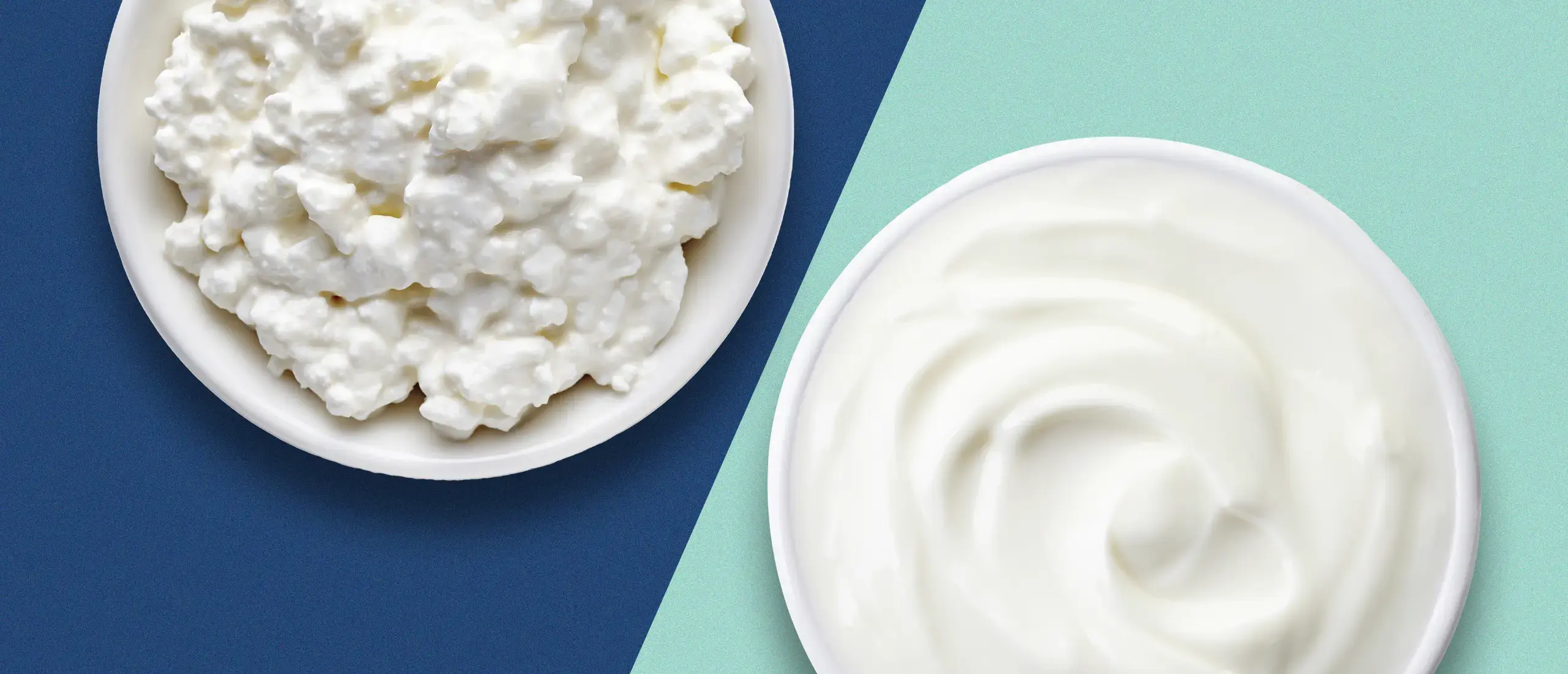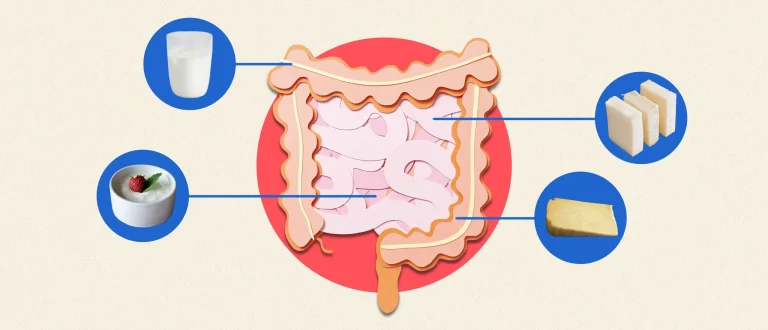Cottage Cheese vs. Greek Yogurt—Which Is Healthier?
- By Matthew Kadey, M.S., R.D.
- March 27, 2024
Our product recommendations are selected by editors, tested first-hand, or expert-approved. We may earn a commission through links on our site.
When it comes to quick, easy, high-protein breakfasts, Greek yogurt reigns supreme. The creamy, tangy yogurt is high-protein, probiotic-rich, and serves as a good base or mix-in for just about anything. Recently though, cottage cheese has been all the rage on social media—which is interesting because cottage cheese can be *quite* polarizing (you either love it or detest it). Still, cottage cheese fans argue that the good stuff is packed with protein, and can do way more than spice up your grandma’s bowl of fruit.
Is it worth giving in to the cottage cheese craze? Or is Greek yogurt actually healthier? To find out, we put cottage cheese and Greek yogurt head-to-head. Here’s how the two popular high-protein dairy products compare.
What Is Greek Yogurt?
Greek yogurt is thicker, tangier, and more protein-rich than regular yogurt. That’s because Greek yogurt is made by straining regular yogurt to drain off some of the liquid—whey, to be more precise—resulting in a thicker dairy product. The straining process requires more milk to achieve the same volume of yogurt. It also concentrates the protein and tangy flavor. Some companies may use thickening agents or other dry ingredients to achieve the same effect—these yogurts are typically labeled as “Greek-Style.”
What Is Cottage Cheese?
Cottage cheese is considered fresh cheese, because it’s not aged or ripened the way hard cheeses like Parmesan, gouda, and cheddar are. It’s made by adding an acid compound or acid-producing culture to milk, which begins the process of separating the liquid whey protein from the milk solids, or curds. The curds are washed, then cream and salt are typically added. The result is a low calorie cheese with a mild flavor, and lumpy texture. It’s often available with different milk fat levels and curd sizes.
Cottage Cheese vs. Greek Yogurt Nutrition
Because the nutrition facts vary by brand, flavor, and levels of fat, it’s hard to give a hard and fast comparison of cottage cheese and Greek yogurt that encompasses everything you’ll encounter in the dairy aisle. To even the playing field we went with plain, low fat (2%) versions of each.
Here’s how an average one cup serving of plain, low-fat Greek yogurt and cottage cheese compare, according to the USDA (1, 2).

Calories
One cup of low-fat plain Greek yogurt contains 179 calories, while one cup of low-fat cottage cheese contains about 180 calories—a virtual tie.
Protein
Cottage cheese and Greek yogurt are also evenly matched for protein—both raking in 24 grams of high-quality protein per one-cup serving. For most adults, a meal should have at least 20 to 30 grams of protein, especially if you’re trying to build muscle (3). If you eat a cup of either Greek yogurt or cottage cheese, you’ll easily meet the mark.
Greek yogurt and cottage cheese are a combination of whey and casein protein—but both are mostly casein (around 80%), since most of the whey is strained during production. Casein digests slower than whey. The slow, steady release of amino acids makes it ideal for staving off hunger and providing slow and steady nutrition, such as before bed or a morning packed with non-stop meetings. One review suggests that eating casein-rich foods before bed could help preserve and build muscle while you sleep (4).
Fat
Both low-fat Greek yogurt and cottage cheese deliver nearly identical (and relatively low) amounts of total fat and saturated fat. You’ll get more fat in full-fat varieties, and less in fat-free products. Which variety you choose comes down to your goals.
Fat-free and lower-fat varieties will save you a few calories, which may be beneficial if you’re looking to lose weight. Full-fat varieties tend to be more satisfying and filling. Low-fat—which is typically 2% milk fat—is a happy medium that’s still filling and flavorful without going too heavy on saturated fat.
The American Heart Association (AHA) recommends keeping saturated fat intake (which is mainly found in red meat and full-fat dairy) under five to six percent (5). However, emerging research suggests that full-fat dairy products might not raise the risk of heart disease and early death like eating fatty meats (6, 7).
In fact, full-fat dairy may be protective against the risk of hypertension and metabolic syndrome (8). This might be due to the nutrient synergy in dairy including quality protein, beneficial fats, and numerous vitamins and minerals.
Sugar
Plain, low-fat Greek yogurt and cottage cheese deliver roughly the same amount of sugar: nine grams per one-cup serving. This sugar mainly comes from naturally occurring lactose and doesn’t pose the same health risk as the added sugar found in most flavored options like vanilla Greek yogurt or fruit-on-the-bottom cottage cheese.
For instance, a ¾ cup serving of Chobani Vanilla Nonfat Greek Yogurt packs 11 grams of added sugar. The AHA suggests that adult men limit their intake of added sugar to no more than 36 grams (9 teaspoons) a day (9). Your best bet to keep added sugars at a minimum is to stick with plain versions and add fresh fruit for sweetness.
Sodium
Cottage cheese tends to have significantly more sodium than Greek yogurt. One cup of cottage cheese can pack upwards of 700mg, while a cup of Greek yogurt has just 83mg. The USDA recommends limiting sodium to 2,300mg per day (10). A sodium-heavy diet has been linked to high blood pressure, heart disease, stroke, and kidney disease (11).
Interestingly, one study suggests that cottage cheese is associated with a reduced risk of cardiovascular disease (12). But more research is needed. To keep sodium in check, scan cottage cheese labels for lower sodium options.
Calcium (and other micronutrients)
Like most dairy products, both cottage cheese and Greek yogurt are considered good sources of calcium—a mineral most people need more of (13). However, Greek yogurt does have a slight edge. One cup of Greek yogurt contains 282 mg of calcium, while a cup of cottage cheese has 227 mg.
Greek yogurt also comes out slightly ahead in other important vitamins and minerals, including phosphorus, potassium, vitamin A, and vitamin B12—which plays an important role in energy production. Cottage cheese has a slight advantage on selenium, a nutrient that helps make DNA, and protects against cell damage (14).
Still, these differences are small, and both cottage cheese and Greek yogurt can make important micronutrient contributions to your daily diet.
Probiotics
Since Greek yogurt is fermented, it’s more likely to contain probiotics—the beneficial bacteria that support immune and digestive function. Some cottage cheese is fortified with live and active cultures to provide the same gut-boosting benefits as yogurt, but this is a rarity not a rule.
That said, not all Greek yogurts at the supermarket are probiotic superstars. Some yogurt is heat treated, which ends up killing off the live bacteria. To determine if a Greek yogurt or cottage cheese has probiotics, look for labels that list colony-forming units (CFUs) or the live bacteria per gram. If the label says “Live and Active Cultures” it means the product contains a minimum of 1,000,000 CFUs of probiotics (15).
Nutrition Winner: Greek Yogurt
Greek yogurt wins by a slight margin. It tends to consistently contain more probiotics and calcium, and less sodium than cottage cheese. Still, both Greek yogurt and cottage cheese are healthy high-protein snacks and are good sources of several important micronutrients.
The Healthiest Greek Yogurt
Want to load up on the good stuff? There are a dizzying array of Greek yogurts to choose from. We’ve rounded up the best options below that have no added sugar, short ingredient lists, and avoid artificial ingredients, stabilizers, and thickening agents which add calories and have little nutritional value.
The Healthiest Cottage Cheese
If you’re open to giving cottage cheese a chance, scan the dairy aisle for short ingredients lists (milk, cream, salt, and probiotics), lower sodium (less than 400 mg for a half-cup serving), and no added sugar. Here are our top picks for taste, texture, and nutrition.
References
1. U.S. Department of Agriculture (2019). Yogurt, Greek, Low Fat Milk, Plain.
2. U.S. Department of Agriculture (2019). Cheese, Cottage, Lowfat, 2% Milkfat.
3. Schoenfeld, B. et al. (2018). How Much Protein Can the Body Use in a Single Meal for Muscle-Building? Implications for Daily Protein Distribution.
4. Snijers, T. et al. (2019). The Impact of Pre-Sleep Protein Ingestion on the Skeletal Muscle Adaptive Response to Exercise in Humans: An Update.
5. American Heart Association (2021). Saturated Fat.
6. Mente, A. et al. (2023). Diet, Cardiovascular Disease, and Mortality in 80 Countries.
7. Alexander, D. et al. (2016). Dairy Consumption and CVD: A Systematic Review and Meta-Analysis.
8. Bhavadharini, B. et al. (2019). Association of Dairy Consumption with Metabolic Syndrome, Hypertension, and Diabetes in 147,812 Individuals From 21 Countries.
9. American Heart Association (2021). How Much Sugar Is Too Much?
10. U.S. Department of Agriculture (2020). Dietary Guidelines For Americans 2020-2025.
11. Centers for Disease Control and Prevention (2023). Sodium Intake and Health.
12. Pozzobon, V. et al. (2019). Cottage Cheese in Diet.
13. National Institutes of Health (2024). Calcium.
14. National Institutes of Health (2021). Selenium.
15. Harvard T.H. Chan School of Public Health (2019). Yogurt.












